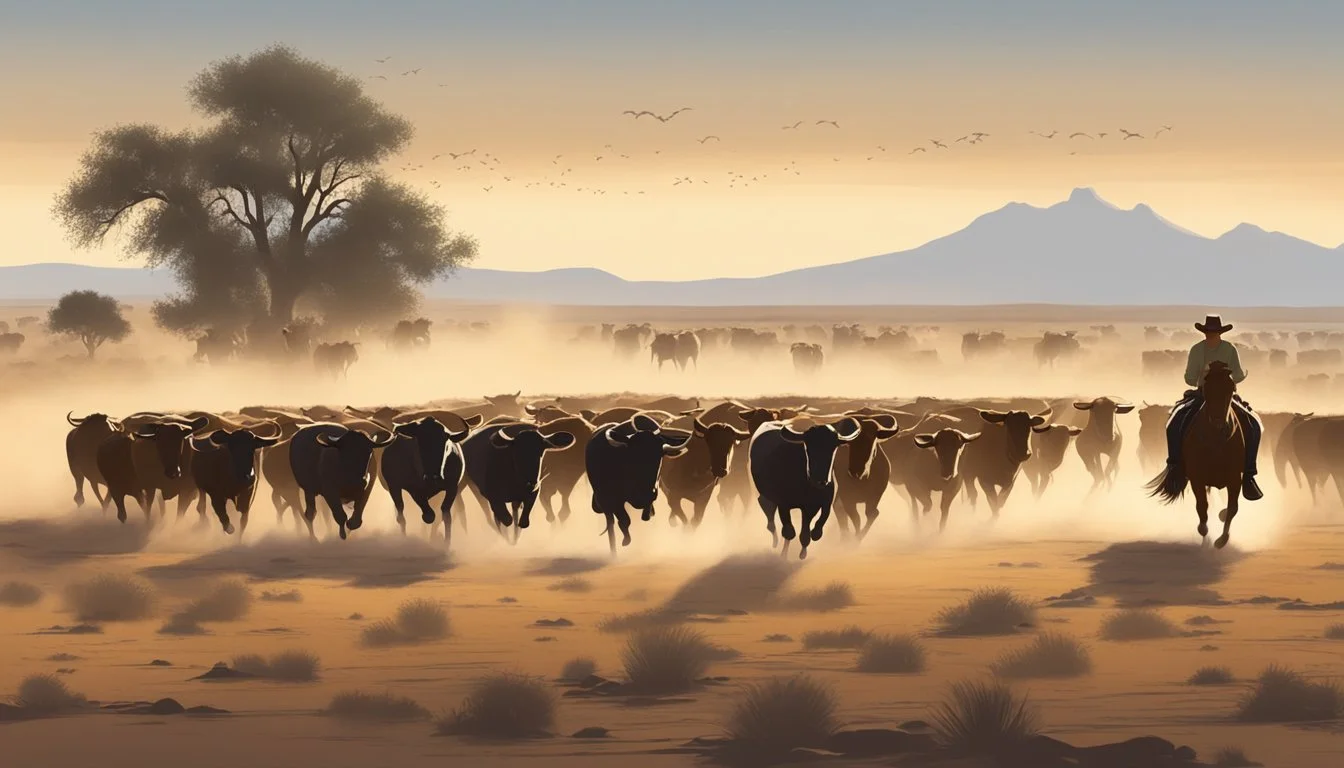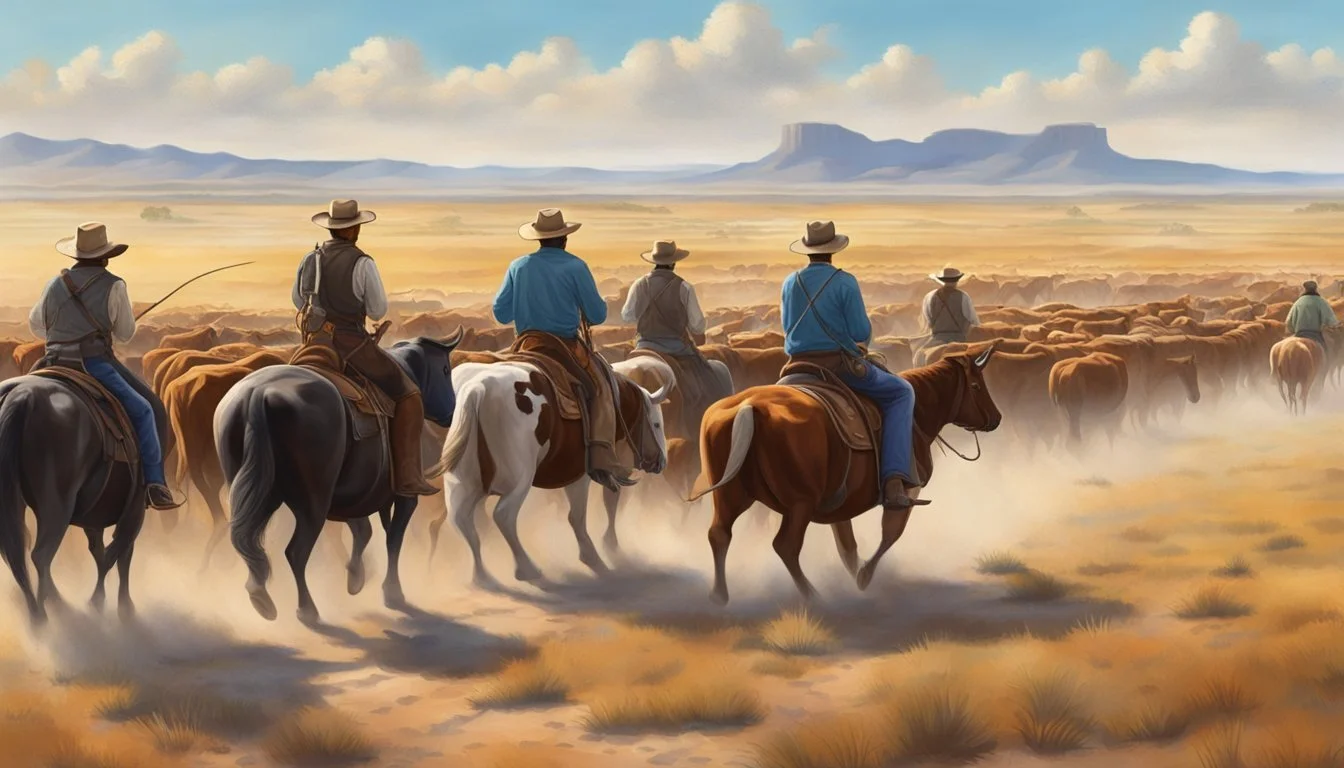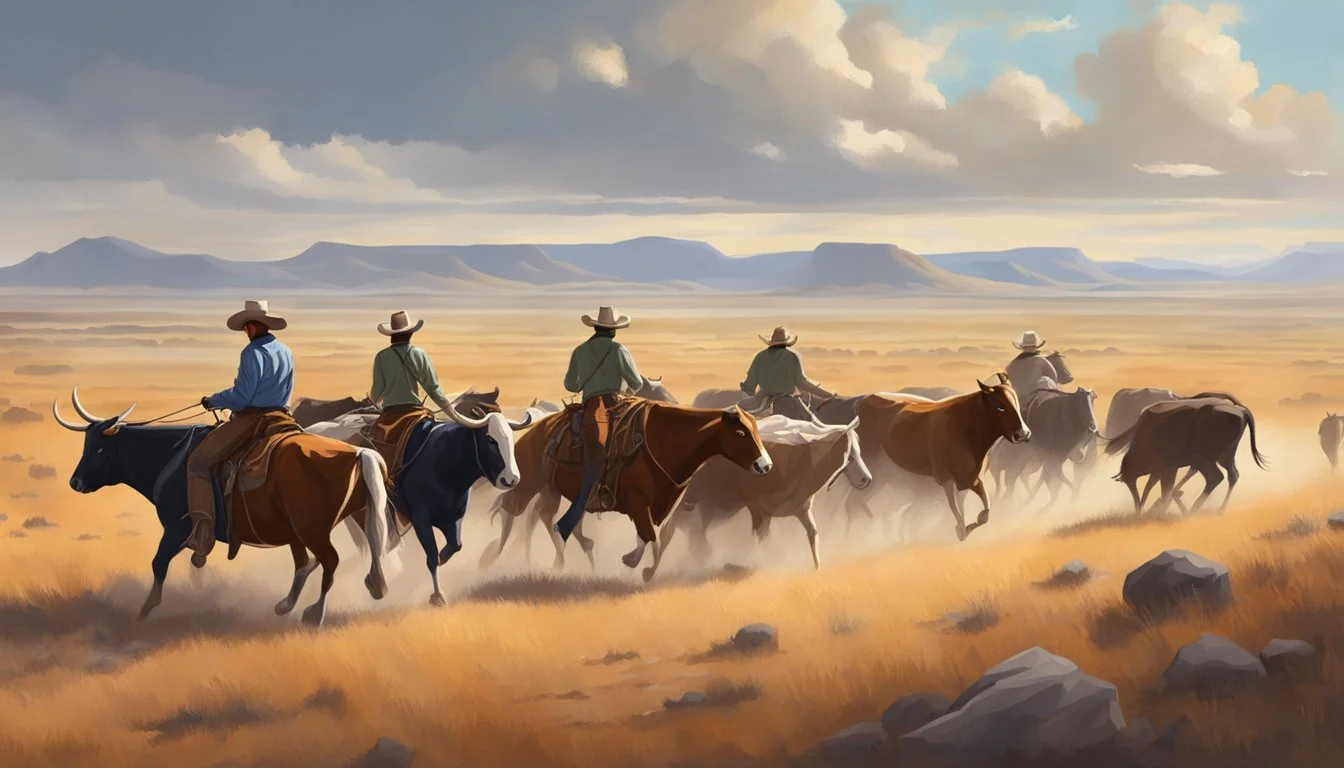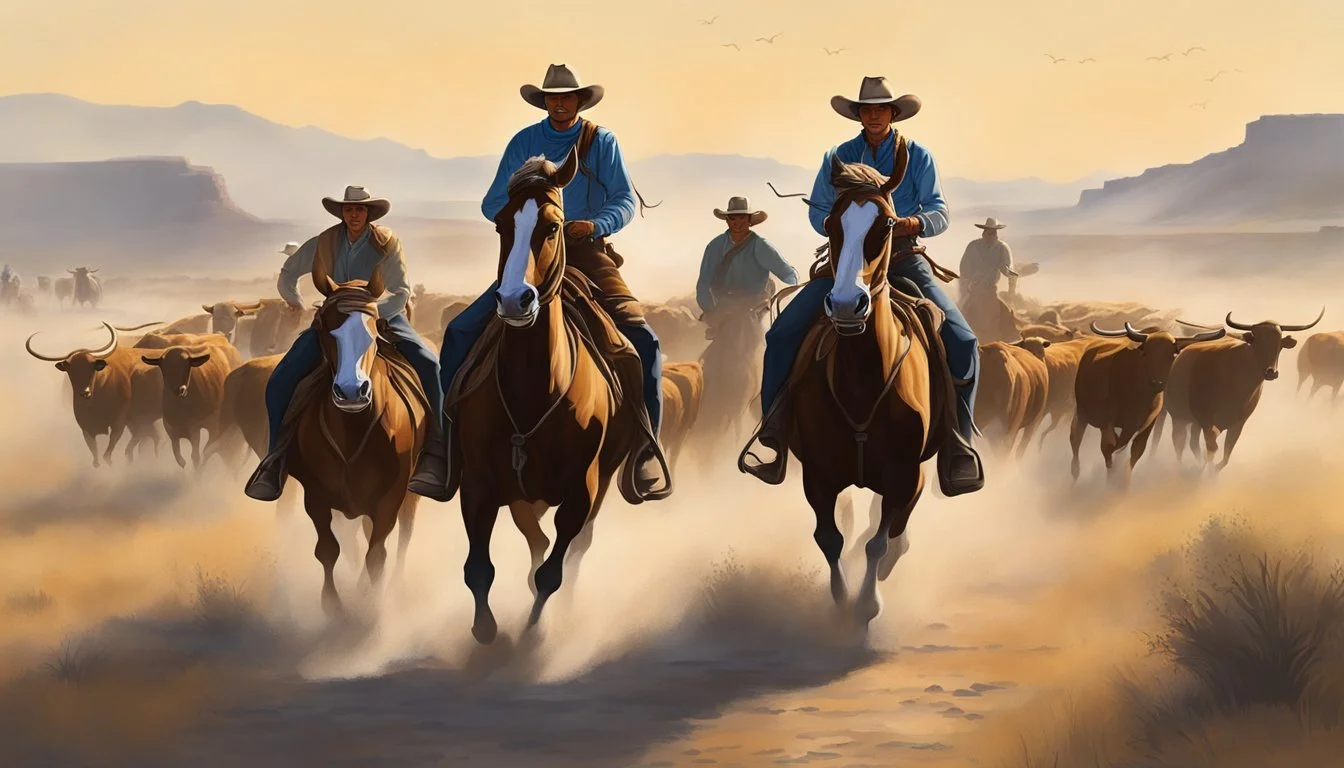The Legacy of Texas Cattle Drives
Tracing Their Historical Routes and Lasting Influence
Texas cattle drives, a pivotal aspect of the American West, have long captured the imagination of historians and enthusiasts alike. Spanning from the mid-1860s to the late 1880s, these drives were critical in shaping the economic and cultural landscapes of the United States during the post-Civil War era. These endeavors embarked from the Lone Star State to various northern markets, becoming the lifeblood of the Texas economy and heralding the rise of the iconic cowboy figure. The cattle drive era was a reflection of a growing nation in need of a stable supply of beef, driven by increased demand from urban centers in the East.
The network of trails that formed the arteries of this massive movement of livestock included the Chisholm Trail, Goodnight-Loving Trail, Western Trail, Shawnee Trail, and Texas Road cattle trail. Texas cowboys herded millions of cattle along these routes, overcoming natural obstacles, weather, and the perils of long journeys on the frontier. The Chisholm Trail, established by Jesse Chisholm, became one of the most significant routes, facilitating the transfer of cattle from ranches in Texas to railheads in Kansas. The efficiency of these drives not only supported the growing demand for beef but also sculpted a new American archetype—the cowboy—rooted in the spirit of adventure, independence, and hard work.
The legacy of the Texas cattle drives is a tapestry woven with economic, social, and cultural significance. While the golden age of cattle drives was relatively brief, their impact echoes through the American ethos. These drives were instrumental in rousing the cattle industry, establishing the economic foundation for many Texas ranchers, and solidifying the Old West's place in history and legend. As the drives ceased with the advent of railroads reaching Texas and changes in land use policies, they left an indelible mark on the identity of the West and the broader American narrative.
The Roots of the Texas Cattle Drives
The cattle drives of Texas hold a vital place in American history, creating a legacy influenced by economic necessity, distinctive cattle breeds, and diverse cultural contributions.
Post-Civil War Economic Factors
With the end of the Civil War, Texas was left with large cattle populations but a devastated economy. The demand for beef in the north and the emergence of railheads provided a lucrative opportunity for Texas to rebuild financially. Profits from cattle selling far exceeded the cost, motivating ranchers to drive their herds hundreds of miles across open territory for gold in the booming beef markets.
The Rise of the Longhorn Breed
The Longhorn breed, with its Spanish origins, thrived in the Texan landscape. Hardy and able to forage over extensive ranges, Longhorns became the favored cattle for drives due to their resilience against the harsh conditions of the trail. Texas Longhorns were also carriers of Texas fever, which, while typically not affecting them, posed a threat to local cattle populations along the trails.
Key Figures in Cattle Driving History
Jesse Chisholm, Oliver Loving, and Charles Goodnight were notable trailblazers. Goodnight and Loving devised the Goodnight-Loving Trail, while Chisholm established the Chisholm Trail. These individuals stand out as iconic trail bosses and drovers who shaped the traditional cattle drives, elevating profit and efficiency to new levels.
Cattle Drive Routes and Trails
The Chisholm Trail led to Abilene, the Shawnee Trail to Kansas, the Goodnight-Loving Trail headed towards New Mexico and Colorado, and the Western Trail reached railheads in Dodge City. The selection of trails was crucial to avoid the spread of Texas fever and to navigate through Indian Territory relating to indigenous agreements.
Life of a Cowboy on the Trail
A cowboy's life on the trail was arduous and filled with daily challenges. From crossing rivers to managing stam pedes, cowboys, alongside drovers and wranglers, worked tirelessly. A typical trail herd included not just the cowhands but also indispensable roles like the cook, horse wrangler, and the trail boss, each with specific duties from flank to drag.
The Impact of Native American and Mexican Vaqueros
Vaqueros, the original cowhands of North America, significantly influenced the cowboy culture in Texas. Their techniques in cattle handling, roping, and riding were adopted by the American cowboys. The blend of Native American and Mexican vaquero skills contributed deeply to the success and culture of the cattle drives.
Logistics and Responsibilities
Executing a cattle drive required meticulous planning. Trail bosses were central figures organizing the remuda (pool of mounts) and managing the chuckwagon. Each cowboy had precise responsibilities from leading the herd to manning positions around it, such as flank or drag, with the wranglers maintaining the horsepower via the remuda and mules pulling the indispensable chuckwagon.
The Cattle Drive Era: Expansion and Routes
The era of the cattle drives saw massive herds moved across the United States, creating new economic pathways and altering the landscape of the American West. These drives typically spanned hundreds of miles and were essential for connecting the cattle markets of Texas with demand in the North and East.
The Chisholm Trail and its Economic Influence
The Chisholm Trail, established in 1865, was a primary route for moving Texas cattle northward. Its economic influence peaked during 1867, when the trail from south Texas to Abilene, Kansas became the main conduit for livestock, channeling vast numbers to railheads for Eastern markets, particularly in Chicago.
Goodnight-Loving Trail: Pushing Westward
The Goodnight-Loving Trail was carved by Charles Goodnight and Oliver Loving in the late 1860s. It branched westward from Texas through New Mexico, up to Colorado, opening crucial markets. It facilitated the expansion of cattle drives beyond the central United States and proved vital for supplying new territories.
Western Trail to Dodge City and Beyond
The Western Trail, leading to Dodge City, Kansas, and even farther north, became prominent after the overcrowdedness of the Chisholm Trail. It served as a key channel for Texas cattle towards northern markets, accommodating the increasing drive demands of the post-Civil War boom.
Minor Routes and Their Contributions
Shawnee Trail: Ran through Indian Territory, but was less favored due to friction with farmers and native tribes.
Texas Road Cattle Trail: A lesser-known but significant path that contributed to the dispersion of livestock.
Challenges Along the Trails: Geography and Climate
Cattlemen faced diverse challenges including:
Geography: Rough terrain and the crossing of major rivers like the Pecos and Rio Grande.
Climate: Incidents of drought on the Great Plains could devastate grasslands, essential for cattle sustenance.
Interactions with Settlers, Farmers, and Native Tribes
Cattle drives often passed through diverse territories impacting various groups:
Farmers: Tensions arose as vast herds trampled crops.
Native Tribes: Drove through Indian Territory, causing confrontations and necessitating negotiations.
Settlers: Adapted to and sometimes capitalized on the flux of cattlemen and herds.
End of the Cattle Drive Era
The closure of cattle drive operations was precipitated by the expansion of railroads, the emergence of barbed wire fencing, and a transition towards stationary cattle ranching, which fundamentally altered the economic and social landscapes of the American West.
The Advent of Railroads and Their Impact
The development of railroad infrastructure dramatically transformed the cattle industry. Railheads reached Texas, which allowed for the transportation of meat to markets far more efficiently than the slow, labor-intensive drives. Abilene, Kansas, became a prominent railhead, where cattle from Texas were loaded onto trains, signaling a shift from the traditional overland routes.
The Introduction of Barbed Wire and Fencing
With the invention of barbed wire in the 1870s, open-range ranching began to decline. Barbed wire provided a means to cheaply and effectively fence in vast areas of land, which negated the necessity for open-range drives to move cattle. This innovation enabled ranchers to control breeding, manage herds more efficiently, and protect their cattle from rustling.
Shift to Ranching and Sedentary Cattle Rearing
The focus shifted from seasonal, long-distance cattle drives to a sedentary approach to cattle rearing, known as ranching. This allowed for year-round management and cultivation of cattle herds, leading to increased profitability for ranchers. The emphasis was on enhancing the quality of the beef and expanding cattle ranching operations.
Economic and Societal Changes
As the era of cattle drives concluded, the associated cowboy culture faded, supplanted by the rising prominence of the rancher and a more corporate approach to cattle and meat production. Financial gains no longer lay in the perilous journey of drives but in the proficiency of breeding and selling beef directly via railroads. This had a considerable impact on the economies of both Texas and Kansas, restructuring societal roles and business methods in the West.
The Legacy of Texas Cattle Drives
The Texas cattle drives of the 19th century were pivotal in forging a unique American cultural identity, shaping the economic and political landscape in Texas, revolutionizing the meat industry, and creating a lasting heritage that continues to draw interest and tourism.
Influence on American Culture and Mythology
Cattle drives became emblematic of the American frontier spirit, contributing to the mythology of the cowboy as a rugged and independent figure. They've been immortalized through countless films, books, and songs, which celebrate the cowboy's iconic status and enduring role as a symbol of American resilience.
The Role in Shaping Texas's Identity
The success of the cattle drives had a profound impact on Texas's socio-economic development. The state's identity is intricately linked with the image of the longhorn, the hardy cattle breed that was driven on these trails, and the cowboy, who managed the herds. These drives helped establish Texas as a key player in the national economy and played a role in healing the state post-Civil War.
Contribution to the Growth of the Meat Industry
Texas cattle drives were crucial in meeting America's growing demand for beef in the late 19th century. Herds of longhorns were driven hundreds of miles along trails such as the Chisholm Trail to railway hubs like Chicago, which became the center for meat packing and distribution. This facilitated the expansion of a nationwide meat industry.
Preservation of History and Tourism
Today, the historical significance of cattle drives is preserved through various means. Monuments, museums, and dedicated parks, like in Fort Worth, offer insights into the past. These sites and the historical reenactments of trail drives continue to attract tourists, celebrating Texas's rich heritage and the enduring legacy of the cattle drive era.
Conclusion
The Texas cattle drives, which spanned from the 1860s to the mid-1890s, left an enduring mark on the United States. They established the Lone Star State's ranching economy and contributed significantly to the nation's beef industry. The iconic Chisholm Trail and others such as the Goodnight-Loving and Shawnee Trails served as vital conduits for livestock and helped forge paths for trade and settlement across the West.
The Heritage of the Trails:
The routes that cowboys followed are etched into the American cultural landscape. They highlight the grit and determination of those involved in the historic drives and are commemorated through various memorials and historic sites.
Cultural Impact:
Cowboy archetype: Texas cattle drives shaped the image of the American cowboy.
Rodeo and Western music: These drives influenced these entertainment forms.
Culinary traditions: Texas barbecue and beef cuisine trace their origins to the drives.
Legacy:
Economic development: These drives contributed to Texas' transition from a war-torn state to a thriving agricultural hub. The need for efficient cattle transport fostered innovations that have rippled through time, influencing current livestock handling and transport methods.
In Conclusion, the legacy of the Texas cattle drives unravels in the fabric of today's traditions, economies, and cultural expressions. These historical events propelled a state and a nation forward, shaping an identity that resonates with the values of endurance, enterprise, and adventure.





